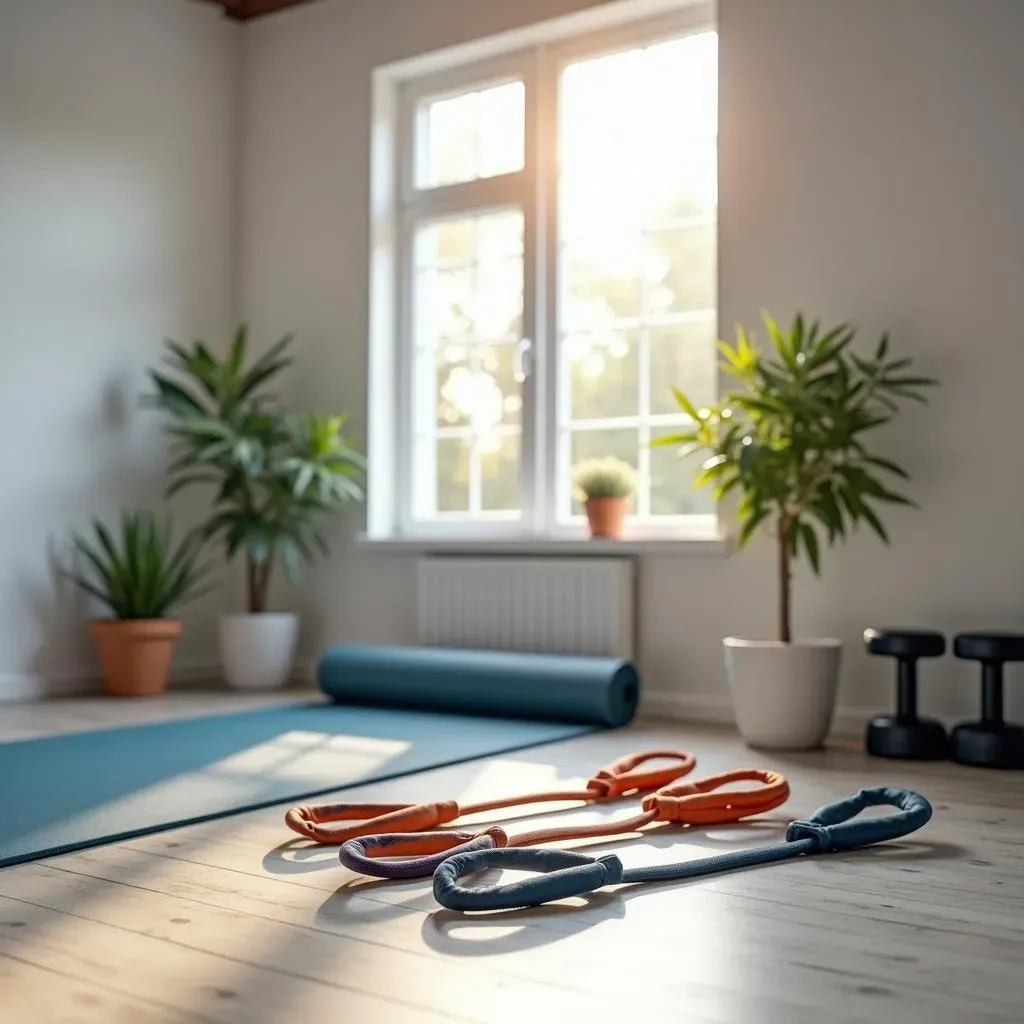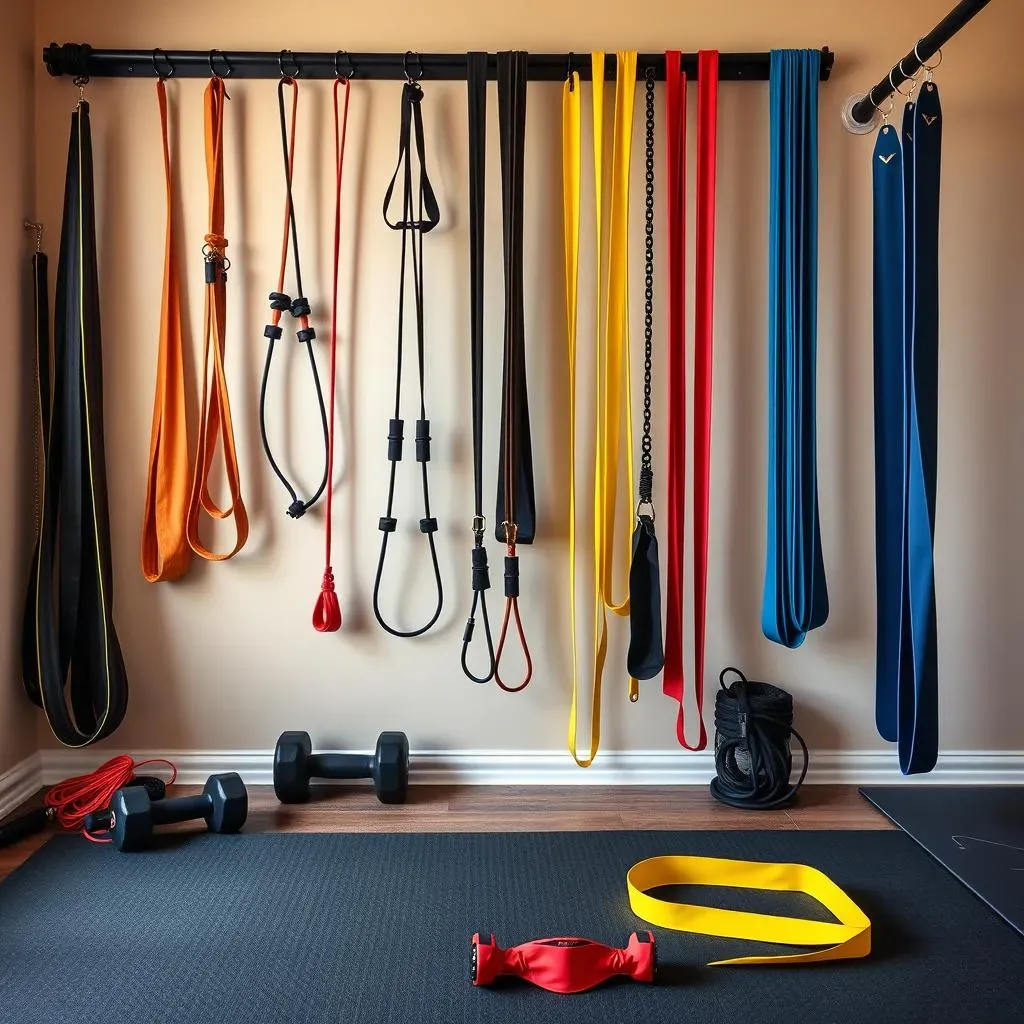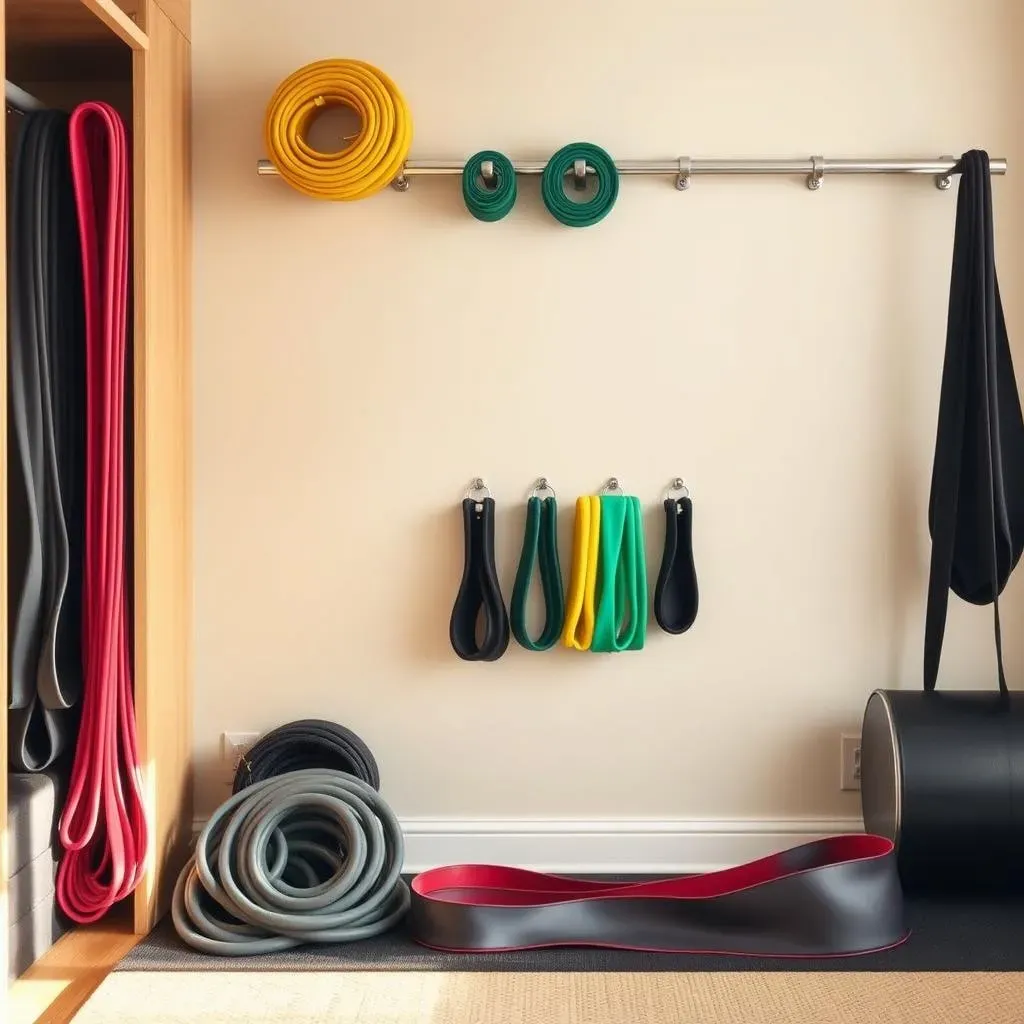Table of Contents
Ready to ditch the crowded gym and sculpt your dream physique from the comfort of your own home? Then it's time to explore the world of home gym equipment resistance bands. These versatile tools are a game-changer, offering a full-body workout that targets every muscle group, without the need for bulky, expensive equipment. Whether you're a seasoned fitness enthusiast or just starting your journey, resistance bands can be easily integrated into your routine, providing adjustable resistance levels to match your strength and goals.
Why Home Gym Equipment Resistance Bands Are a MustHave
Why Home Gym Equipment Resistance Bands Are a MustHave
so you're thinking about leveling up your home workouts? Let me tell you, home gym equipment resistance bands are where it's at. Seriously, they're like the Swiss Army knife of fitness. Forget those clunky dumbbells hogging space; resistance bands offer a killer full-body workout without turning your living room into a weightlifting dungeon. They're portable, affordable, and adaptable to any fitness level, making them the perfect addition to any home gym setup. Plus, they add a unique challenge to your muscles, helping you build strength, improve flexibility, and enhance your overall fitness.
Choosing the Right Resistance Bands for Your Home Gym
Choosing the Right Resistance Bands for Your Home Gym
so you're sold on the idea of resistance bands, awesome! But hold up – not all bands are created equal. Choosing the right resistance bands for your home gym is crucial to getting the most out of your workouts and avoiding injury. Think of it like this: you wouldn't wear shoes that are three sizes too big for a marathon, right? Same principle applies here.
First, let's talk about the different types. You've got your loop bands, which are great for lower body exercises and stretching. Then there are tube bands with handles, offering a more traditional weightlifting feel. And don't forget the power bands, those big, thick loops perfect for assisted pull-ups and adding resistance to squats. Each type has its strengths, so consider what exercises you'll be doing most often.
- Loop Bands: Ideal for glute activation, leg workouts, and stretching.
- Tube Bands with Handles: Mimic weightlifting exercises, great for upper body.
- Power Bands: Best for assisted exercises like pull-ups and adding resistance to compound movements.
Next up is resistance level. Bands come in different colors, each representing a different level of resistance. As a general rule, lighter colors offer less resistance, while darker colors provide more. If you're just starting out, grab a set with varying resistances so you can gradually increase the challenge as you get stronger. Trust me, starting too heavy is a recipe for sore muscles and discouragement. It’s better to start light and work your way up.
Effective Exercises Using Resistance Bands for a FullBody Workout
Effective Exercises Using Resistance Bands for a FullBody Workout
Upper Body Blast with Resistance Bands
Alright, let's get into the good stuff: the exercises! When it comes to effective exercises using resistance bands for a full-body workout, the possibilities are pretty much endless. But to keep things simple, let's break it down by body part. For the upper body, resistance bands are fantastic for mimicking traditional weightlifting movements. Think bicep curls, tricep extensions, rows, and chest presses. The key here is to focus on controlled movements and proper form. No need to rush through reps – feel the burn! For example, stand on the band and curl upwards, or secure the band and pull it towards your body.
One of my favorite upper body exercises is the resistance band chest press. Simply loop the band around your back, hold the ends in your hands, and press forward like you would with dumbbells. You can do this standing or lying down for a different angle. The resistance increases as you press, giving you a killer chest workout without any heavy weights. Another great option are band pull-aparts. They're great for posture and shoulder health. Hold the band with both hands and pull it apart, squeezing your shoulder blades together.
Here's a quick guide to resistance band color-coding:
Band Color | Resistance Level | Typical Use |
|---|---|---|
Yellow | Light | Beginners, warm-ups |
Red | Medium | Intermediate exercises |
Green | Heavy | Advanced strength training |
Blue | Extra Heavy | Experienced users, powerlifting |
Lower Body and Core Power with Resistance Bands
Now, let's move on to the lower body and core. Resistance bands are amazing for targeting those glutes, quads, and hamstrings. Squats, lunges, and glute bridges are all taken to the next level with the added resistance. Simply place a loop band around your thighs or ankles to increase the intensity. Trust me, you'll feel the burn in places you never knew existed! Another great exercise are banded walks. Place the band around your ankles and step side to side. Your glutes will thank you later.
Don't forget about your core! Resistance bands can be used to add a challenge to exercises like Russian twists, wood chops, and even planks. For example, loop a band around a stable object and perform wood chops, rotating your torso while pulling the band across your body. This not only strengthens your core but also improves your rotational power. Remember to keep your movements controlled and focus on engaging your core muscles throughout the exercise. The key is to maintain proper form and avoid using momentum to swing the band.
Maximizing Your Home Gym with Resistance Bands: Tips and Tricks
Maximizing Your Home Gym with Resistance Bands: Tips and Tricks
so you've got your bands, you know the exercises, now let's talk about truly maximizing your home gym with resistance bands. It's not just about going through the motions; it's about smart training. One of the biggest tips I can give you is to focus on progressive overload. Just like with weights, you need to gradually increase the challenge to keep seeing results. This could mean using a heavier band, increasing the number of reps, or shortening the rest periods. Don't be afraid to experiment and push yourself, but always listen to your body and prioritize proper form over ego. Also, consider combining resistance bands with bodyweight exercises for a super effective workout. Think banded push-ups, squats, or planks for an extra challenge. The possibilities are endless!
Another key tip is to vary your workouts. Doing the same exercises day in and day out can lead to plateaus and boredom. Mix things up by trying new exercises, changing the order of your routine, or incorporating different training techniques like drop sets or supersets. This will not only keep your muscles guessing but also prevent you from getting mentally burnt out. Plus, it's a great way to discover new and exciting ways to use your resistance bands. For example, try pairing a resistance band bicep curl with a bodyweight tricep dip for a killer arm workout.
And finally, don't underestimate the power of proper warm-up and cool-down. A few minutes of dynamic stretching before your workout and static stretching afterward can make a huge difference in preventing injuries and improving flexibility. Use your resistance bands to assist with stretches like hamstring stretches, shoulder stretches, and chest stretches. This will not only prepare your body for the workout ahead but also help it recover afterward. Remember, consistency is key when it comes to fitness, so make sure you're taking care of your body and setting yourself up for long-term success.
- Progressive Overload: Gradually increase resistance or reps.
- Workout Variety: Mix up exercises to avoid plateaus.
- Warm-up/Cool-down: Prevent injuries and improve flexibility.
Maintaining and Storing Your Home Gym Equipment Resistance Bands
Maintaining and Storing Your Home Gym Equipment Resistance Bands
Washing and Cleaning Your Bands
Alright, let's talk about keeping those bands in tip-top shape. Think of it this way: you wouldn't wear the same workout clothes day after day without washing them, right? Same goes for your resistance bands! Sweat, dirt, and grime can break down the material over time, leading to cracks and tears. Plus, nobody wants to work out with sticky, smelly bands. So, how do you keep them clean? The good news is it's super easy. Just grab a mild soap (like dish soap) and some warm water. Gently wash the bands, rinse them thoroughly, and let them air dry. Avoid using harsh chemicals or putting them in the washing machine, as this can damage the latex or rubber.
Once they're clean, make sure they're completely dry before storing them. Moisture can lead to mold and mildew, which is definitely not something you want to deal with. You can speed up the drying process by patting them down with a clean towel. And while you're at it, give them a quick inspection for any signs of wear and tear. Catching small tears or cracks early can prevent them from becoming bigger problems later on. Remember, a little maintenance goes a long way in extending the lifespan of your resistance bands.
Here's a quick checklist for cleaning your resistance bands:
- Wash with mild soap and warm water.
- Rinse thoroughly.
- Air dry completely.
- Inspect for wear and tear.
Proper Storage Techniques
Now that your bands are clean and dry, let's talk storage. How you store your home gym equipment resistance bands can have a big impact on their longevity. The key is to keep them away from direct sunlight, extreme temperatures, and sharp objects. Sunlight can cause the latex to break down and become brittle, while extreme temperatures can warp or melt the material. And obviously, sharp objects can puncture or tear the bands, rendering them useless. So, where's the best place to store them? A cool, dark, and dry place is ideal. Think a drawer, a closet, or a storage bin. Avoid leaving them in your car, where they can be exposed to extreme heat and sunlight.
When storing your bands, try to avoid stretching or twisting them excessively. This can cause them to lose their elasticity and become less effective over time. Instead, gently coil or fold them and store them in a way that minimizes stress on the material. You can also use a storage rack or a hanging organizer to keep them neatly organized and easily accessible. This not only protects the bands but also makes it easier to find the one you need for your workout. Trust me, nothing's more frustrating than rummaging through a tangled mess of bands when you're trying to get your sweat on.
Extending the Life of Your Resistance Bands
So, you're cleaning and storing your bands properly, great! But there are a few other things you can do to further extend their lifespan. One of the most important is to avoid overstretching them. Each band has a maximum stretch length, and exceeding this can cause it to snap or lose its elasticity. Pay attention to the markings on the band or the manufacturer's recommendations, and never stretch it beyond its limit. Also, be mindful of the surfaces you're using your bands on. Rough or abrasive surfaces can cause friction and wear down the material. Try to use them on smooth, clean surfaces whenever possible, or invest in a resistance band anchor to protect them from damage.
Another tip is to avoid using your bands in chlorinated water, such as swimming pools or hot tubs. Chlorine can degrade the latex and shorten its lifespan. If you do use them in water, make sure to rinse them thoroughly with fresh water afterward. And finally, consider replacing your bands every year or two, depending on how frequently you use them. Even with proper care, resistance bands will eventually lose their elasticity and become less effective. Replacing them regularly will ensure that you're always getting the most out of your workouts and avoiding potential injuries.
Here are some additional tips to maximize the lifespan of your resistance bands:
Tip | Description |
|---|---|
Avoid Overstretching | Do not exceed the maximum stretch length. |
Use on Smooth Surfaces | Minimize friction and wear. |
Avoid Chlorinated Water | Chlorine degrades the latex. |
Replace Regularly | Replace every 1-2 years for optimal performance. |
Elevate Your Fitness Journey with Home Gym Equipment Resistance Bands
Incorporating home gym equipment resistance bands into your fitness routine is a simple yet powerful way to achieve your goals. From building strength and increasing flexibility to improving overall fitness, these versatile tools offer endless possibilities for workouts at home. By understanding the different types of bands, mastering effective exercises, and following proper maintenance tips, you can create a personalized workout experience that fits your lifestyle and helps you unlock your full potential. So, embrace the convenience and effectiveness of resistance bands and take your fitness journey to the next level!